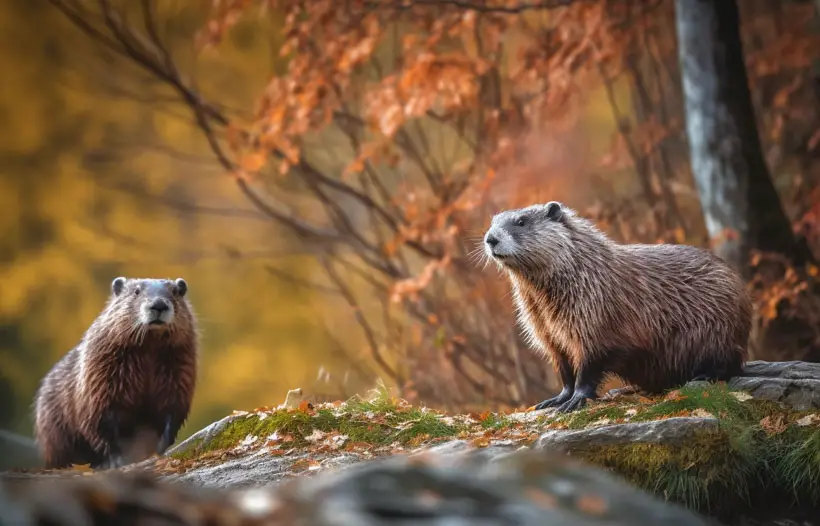Marmot vs. Beaver: Behavior, Habitat, and Physical Characteristics
Both marmot and beaver fall under the order Rodentia, but the family of marmots is Sciuridae, also known as the squirrel family. And marmots are the largest member of this family and fall under the Marmota genus. Conversely, Beavers belong to the Castoridae family and Castor genus.
So, what is the difference between a marmot vs beaver? Mountainous areas, grasslands, and meadows are the favorite habitats of marmot species. And Beaver’s habitat preferences are freshwater ecosystems. Although they share some similar traits in some cases, their key differences include physical characteristics, habitat, diet, winter activity, communication, and more.
And it is crucial to know these differences to identify these animals from a distance. We will give you a complete overview of the behavior, habit, and physical characteristics of these large rodents. Let’s get started.
Physical Characteristics
Marmots and beavers can be identified with bare eyes if you know the differences of physical characteristics between them. Let’s discuss their physical characteristics accordingly.

Size and Weight
The most prominent difference between these two animals is their size. Marmots are much smaller than beavers. Though the size can vary depending on their species, age, etc., marmots are usually 17-28 inches long.
And they weigh about 4.5-24 pounds. Marmots will have round ears and tails, similar to squirrels. If you look at the legs, the forelegs of marmots are shorter than the hind legs. Groundhogs, a species of marmots, also have similar legs.

However, beavers are way bigger, with an average length of 31-47 inches. And they can weigh about 24-66 pounds. Beavers have flat tails that look like leather.
Fur Color
Both animals have long, coarse fur that helps them maintain their body temperature. Marmots don’t have waterproof furs, but beavers have. They can stay longer in cold water than marmots due to their dense fur.

The fur color may often be similar to each other. For example, both marmots and beavers have brown fur. But beaver fur can sometimes have a black hue.
Teeth
Marmots and beavers have slightly similar teeth profiles. The incisors of marmots are chisel-shaped, which makes it easier for them to munch on vegetables. Beavers usually have smaller teeth than marmots, but their front teeth are bigger. These teeth can be up to 2.5 inches long.
One fun fact is beaver teeth have enamel twice as thick as human teeth. And the presence of iron in their enamel makes their teeth orange.
How Are Physical Characteristics Helpful in Survival?
As marmots typically live in mountainous areas or grasslands, their legs need to carry the body weight. So, marmots have thick, strong legs. Plus, they have sharp claws along with sharp teeth. These physical adaptations help marmots to easily dig burrows and bite on a wide variety of vegetation.
Their tails are thick and fluffy, which is easier to hide when entering burrows. The length of the marmot tail is 10 inches on average.

But beavers have longer forelegs that help them swim easily. They mostly live in aquatic ecosystems, so their tails work as the radar while swimming. And they have a tail almost twice as long as a marmot. So, the larger tail helps them change their directions easily.
Adaptations According to Diet
Though both animals are herbivores, their diets are a bit different. As marmots live in meadows or grasslands, they generally live off of shrubs, grasses, etc. So, their chisel-like incisors help cut the food easily.
And as they hibernate in the winter, they have adapted to store fat in summer. As a result, they can hibernate for longer without any issues.
Beavers usually eat aquatic plants, tree bark, leaves, etc. So, they have slightly larger front teeth to cut through these items easily. Though beavers have smaller teeth inside the mouth, the bite force can be up to 150 psi. So, beavers can easily grind tough plantations.
Behavior
The difference between the wildlife behavior of these two animals relates to their physical appearances. In this section, we will talk about marmot behavior vs. beaver behavior.

Territoriality
The first thing you will notice in marmot behavior is their timid nature. As they are smaller than beavers, they aren’t that aggressive. Marmots dig burrows to live, and they seem to be moderately territorial.
In the presence of any alarming stimuli, they warn intruders with loud whistles and trills. Like most other rodents, marmots usually don’t leave their territory unless it is indispensable.
But beavers are far more aggressive than marmots. Whenever intruders enter their territory, they tend to slap their tails to warn the intruders.
Communication
Marmots use several sounds to communicate with others in the vicinity. They usually whistle, trill, or chuck to grab the attention of other marmots. If they feel threatened, they will make these noises to send warnings. When two marmots meet, they usually trill to greet their friends.

Beavers are lower-pitched animals than marmots. They usually make hissing or growling sounds to send alarm signals. But they make whining noises when meeting friends.
Mating
After exiting hibernation, marmots spread in the area to find female marmots in their burrows. In some cases, male marmots collect dried flowers to attract their partners. Marmot parents can give birth to 9 pups in one breeding season.
Beavers are usually monogamous, but they find new partners after the death of their previous partner. A beaver is ready to mate at three to seven years old. January and February is the mating season of beavers. As female beavers have a 12-hour heated window, mating is much more difficult for beavers. Females signal male beavers by excreting, and males stay close to their partners during mating season.
Behavior in Natural Habitats
The animal behavior of marmots and beavers is quite relaxed in their natural habitats.
- Marmots slowly forage for food around their burrows and can search for food for a few miles.
They behave slightly differently in various habitats. For example, mountain marmots are slow runners, but those living in grasslands or meadows will run very fast.

Around their natural habitats, marmots collect as much food as possible. Their weight can double during the feeding season, as they must store a lot of fat for hibernation.
- Beavers are slower than marmots, as they live in semi-aquatic areas. They often live in the water but can sometimes come to land. During the warm season, they usually feed on aquatic plants, roots, leaves, etc. But they prefer tree bark in winter, especially aspen, birch, willow, etc.
They tend to collect small branches of trees and store them in their lodges. In winter, food becomes scarce, and beavers munch on collected branches. This is because water freezes in winter, and beavers can’t swim much to forage for food.
Alteration of Habitats
- Though marmots are native to mountainous areas, they often alter their habitat to find a better constant food source. It can sometimes be challenging for little marmots to find enough food in the mountains.
So, they shift their habitats to plains or grasslands where they can easily find food.
Foraging in grasslands is also less struggling for marmots. And as the soil in grasslands is softer than in the mountains, marmots can easily dig their burrows there. Plus, they can have an eye for predators in a bigger area, allowing them more time to run from a predator.
- On the other hand, although beavers are seen throughout Alaska and Canada, they usually don’t live in tundras north of these areas. This is because the temperature is frigid there. And the tree growth is limited. So, beavers can’t collect enough food in such areas.
They will typically move to lakes, ponds, or streams to build their dams and lodges. Beaver dams are usually 10 feet tall and about 165 feet wide. They make these dams with tree branches, rocks, etc., and seal everything with mud.

As a result, the water inside the dam becomes slow-moving. And beavers make lodges inside those dams. These lodges are also built with tree branches. Beavers have enough space inside these lodges to store food and give birth.
Habitat
You might already have a brief idea of the differences between marmot habitat vs. beaver habitat. We will discuss more on the differences in their habitats here.
Habitat Preferences
- Marmots prefer to live in mountainous regions because they need to dig burrows beneath rocks. When they do this in cliff areas or rocky mountains, predators can easily approach them or drag them out of their burrows.
- Marmots fear bears so much, and hunting marmots in rocky areas are too difficult for bears. So, marmots can safely live inside their burrows in such areas.
- And beavers prefer semi-aquatic ecosystems because they want a stable base for their lodges. Even if they live in rivers or streams, they build dams to slow the stream down. Beavers build lodges that protect them from predators, extreme temperatures, etc.
- Their lodges have multiple entrances. If a predator approaches their lodges, they can easily escape from their lodges. Swimming in strong stream areas is challenging for beavers, so they prefer calm water. The natural resources management skill of beavers is extraordinary.
Differences Between Marmot and Beaver Habitats

The habitats of these animals are quite different.
- Marmots don’t usually go close to water, and beavers prefer to live in the water most of the time.
- As marmots dig burrows, they don’t need to collect that much building material for their homes. They usually dig tunnels on different levels to live peacefully with their partners.
- But beavers work a lot to collect building materials. After bringing all the materials to their preferred area, beavers must arrange these materials to build dams and lodges. It also requires sealing everything with mud that they collect from ponds or river beds.
- Marmots usually store food inside their bodies, so they need to store less food in their burrows. Still, they will collect dry food to munch on them during the winter.
- Beavers tend to collect and store more food in their lodges.
Impact of Habitat Loss
Due to increased human interaction, marmots are forced to build temporary burrows over short distances. And when their habitats are destroyed, they have threats like coyotes, eagles, foxes, and badgers.
According to biodiversity conservation organizations, the Vancouver Island marmot is the most endangered species.

And the leading cause of the beaver population decrease is the failure of beaver dams. Due to the impact on aquatic ecology, the number of beaver dams falls from 2.39 million to 1.36 million. Among the two beaver species, North American beavers are more common.
If you’re interested in learning more about marmots, you might want to explore other fascinating aspects of these intriguing rodents. At Rodents Fact, we have informative articles on the classification of marmots as rodents and the differences between marmots and prairie dogs. Our article on the classification of marmots as rodents provides an in-depth look at the biological and taxonomical aspects of these intriguing creatures. Meanwhile, our article on marmots vs prairie dogs explores the differences and similarities between these two fascinating rodents, including their physical characteristics, habitats, and behaviors. So, if you want to expand your knowledge about the diverse world of marmots, be sure to check out our articles on the classification of marmots as rodents and marmots vs prairie dogs.FAQs
You might have some more questions about marmots and beavers. Here are answers to frequently asked questions.
Q: Can marmots and beavers be kept as pets?
No. Though marmots are less aggressive within their society, they won’t be the same during human interactions. Plus, they need to chew a lot to trim their teeth, which is harmful to households. Beavers can’t be kept as pets, either.
Q: What should I do if I find a marmot or beaver in the wild?
If you see a marmot or beaver in the wild, it is best to avoid approaching these animals. Don’t try to feed marmots or beavers because they might take you as a threat. Leave them alone and get out of their ways.
Q: Are there any legal restrictions on keeping marmots or beavers as pets?
Yes, it is illegal to keep any of these animals as pets. You will need state and federal licenses for wildlife rehabilitation to move them from their natural habitats.
Conclusion
Despite being rodents, marmots and beavers differ in their habitats, behavior, and physical characteristics. We tried to point out each of those differences in this article.
Knowing these differences will allow you to easily identify these animals and act according to their behavior to maintain biodiversity and improve ecosystem services. And if you know about their natural habitats, it will be easier not to destroy them accidentally.
Accordingly, more research should be done on these animals to prevent extinction. Marmots are already endangered, so protective research is essential. The hard work of beavers is a sight to behold, and it should inspire us to learn more about these furry animals.




